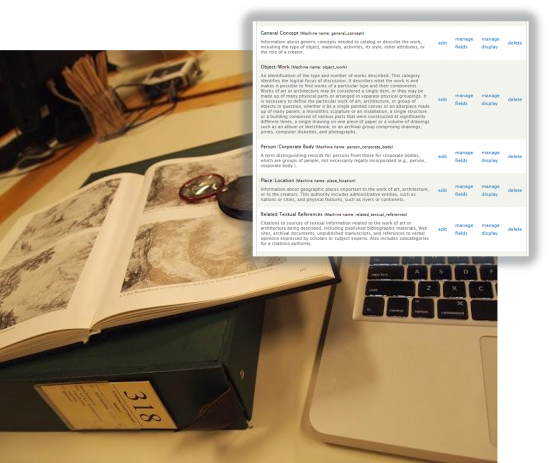Kathryn Stine is Senior Digital Curator the History of Art Department’s Visual Resources Center. In this guest post, she describes the VRC’s current collaboration with DH Fellow and Associate Professor or Art History, Elizabeth Honig.
Art historical research can involve gathering and comparing vast amounts of images, detailed descriptions and metadata about artworks, and related textual resources, all in support of the researcher unearthing relationships and making connections that better contextualize a body of work. Some art historians investigate and make new knowledge about bodies of artwork organized as the creative output of a single artist while others may analyze groupings of work by contemporaneous artists or artists’ workshops. Still others may research bodies of artwork that are related by thematic content, geographic location, or modes of production. And certainly these lines of research are not necessarily mutually exclusive.
Often published with the imprimatur of a scholarly press, catalogues raisonnés are resources that, traditionally, meticulously detail the oeuvre of a particular artist and provide evidence of the provenance and attribution of the artist’s works. As reference sources integral to the study of art history, catalogues raisonnés can also form a backbone from which users compare relationships between artworks, study the creative evolution of an individual artist, or even make connections across networks of distinct artists. However, these printed volumes are extraordinarily expensive to produce and then to purchase. When new information comes to light about the artworks documented in a catalogue raisonné, a new edition must be produced in order to maintain currency. Access to print catalogues raisonnés thus can remain out of reach for researchers not affiliated with a major research library.
Elizabeth Honig, UC Berkeley Associate Professor of Art History, has worked for the past four years on developing an online digital catalogue of the work of Jan Brueghel the Elder and will soon be adding digital catalogues documenting work of others in the Brueghel family. The digital format allows for broad access to images of and details about the work of the Brueghels. A digital format also enables continuous updates, as well as opportunities to engage researchers in conversation about their interpretations of these artworks. With collaborative research funding through Digital Humanities at Berkeley’s Andrew W. Mellon Foundation grant “Capacity Building and Integration in the Digital Humanities”, staff from the Visual Resources Center of the Art History Department are working with Professor Honig and incoming graduate student Jess Bailey to develop the Open Catalogue Raisonné Platform (OCRP), a tool that anyone can use to organize and share their research about a body of artwork. This platform will be implemented in Drupal, an established, extensible open source content management system that is being used to manage and publish the Brueghel catalogues.
The OCRP is intended to provide researchers who may have very little funding and minimal technical expertise with a toolkit comprising customizable Drupal modules as and documentation describing how to put these into practice. The project team began by taking stock of the current Jan Brueghel catalogue’s functionality, and by assessing both other online catalogues raisonnés and the current tools available to publish them in order to better understand how the platform could fit in and potentially address gaps. The team has also been gathering data from prospective users in order to base the platform’s functional requirements and design decisions on research workflows and needs from these core groups: art historians (including independent scholars and those with academic or museum affiliations), students, artists, and information professionals working in libraries, archives, and museums. The team has analyzed the results of a survey, interviews, and walkthroughs of existing online catalogues raisonnés to determine which metadata fields and relationships are critical to include in the platform, how users can configure access to their catalogue’s features, and how data, images, and resources can flow into and out of the platform, potentially integrating with other systems and tools for analysis.
Work on the platform is currently in progress as the team collaborates with a Drupal developer to outline a minimum feature set for the modules, specifying both metadata and interface functionality. Prospective users have identified, in addition to basic descriptive metadata (such as work titles, creators, dimensions, materials, and techniques), metadata and documentation that could prove especially useful in contextualizing and making sense of a body of artwork brought together in an online catalogue. These include related textual references, such as bibliographies, exhibition histories, condition and conservation reports, process documentation and fabrication notes, and provenance, or data about a given artwork’s changes in ownership over time. Additionally, the team is working to ensure that catalogues raisonnés created and published with the platform will use standardized data structures and descriptive vocabularies, thus maximizing the potential for end users to find and understand individual artworks within and beyond their temporal, geo-spatial, and thematic contexts.
Ultimately, the Open Catalogue Raisonné Platform could provide a structured, low-barrier, digital means for researchers of art history to record, store, link, search, and share the images, descriptions, and related resources they use to interpret and make accessible bodies of artwork, whether the organizing principle used to bring the works together is a single biography, a network of artists related by time, place, or theme, or another factor altogether.
